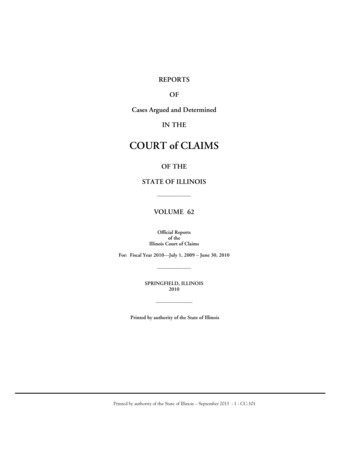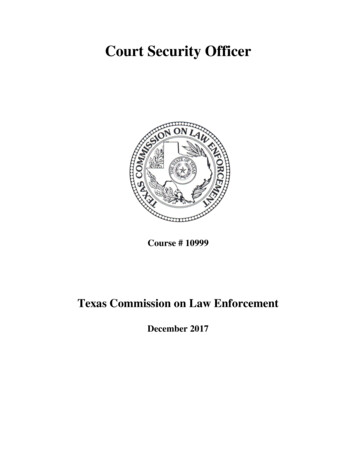
Transcription
Title: Silence! The Court is in Session IntroductionVijay Dhondopant Tendulkar, born in 1928 in Mumbai, was a leading Indian playwright,television writer, literary essayist, journalist, and social commentator primarily in Marathi. He isbest known for his plays Shantata! Court Chalu Ahe.Silence! The Court is in Session is a play written by Vijay Tendulkar in 1963. The play wasoriginally written in Marathi language titled “Shantata! Court Chalu Ahe.” The play was firstperformed in 1967. The play considered to be written with the real life incidents of theplaywright Vijay Tendulkar. The story of the play revolves around the theme of genderdiscrimination and the courtier system of India. Theme of The PlayIt seems that the play is based on the theme of Gender Discrimination. Women are thereal architects of society, she has the power to create, nourish and transform. The societyaround her always had been a challenging. The women in India have never been able to live in acircumstance where they are treated equally. Tendulkar’s “Silence! The Court is in Session is acritique of gender discrimination in patriarchy and the women’s fight against the injustice doneto her. He represents the problems faced by independent women in India.
Characters in The Play[1] Miss Leena BenareMiss Benare is the chief protagonist and heroine of the play. She isthirty four years old, self – dependent successful unmarried schoolteacher. Tendulkar has presented her as an intelligent and maturedlady with her own conviction.[2] Mrs. KashikarMrs. Kashikar is the wife of Mr. Kashikar who represents typicalIndian housewife dependent on her husband for everything.[3] SukhatmeSukhatme plays an important role in the prosecution of Benare. Heis a lawyer – cum – actor and is unsuccessful in his own career.Sukhatme upholds the principle that woman is not fit forindependence.[4] Mr. KashikarMr. Kashikar becomes the judge in the mock trial in the play. He is adisgruntled sadist figure like other men in the play except Samante.He belongs to the category of urban character.[5] SamanteSamante is a rustic uneducated villager in a galaxy of educatedurban characters. He is pure at heart and stands for justice. He is nota professional, but he is honest, helpful and compassionate.[6] Prof. DamleProfessor Damle is a married man live with family. He leaves Benarepregnant and disowned responsibility.[7] Other CharactersThere are some other characters such as Ponkshe, Karnik andRokde. Satirical Attack in The TitleTendulkar satirically attacks on the society with the title “Silence! The Court is inSession.” There is no silence or discipline in the court, and even the wife of the judge Mrs.
Kashikar disturbs the court all the time. Thus, in this way, the word “Silence” seems moreimpactful. The title, “Silence! The Court is in Session” is a powerful satire on modern society.The famous critic N. S. Dharan points out that –It is the imposed silence on Benare that gives the title its uniqueness and tells us aboutthe mockery in the title.So, here, the title can be justified as a satirical attack on the people of modern society. Judicial Register: The First TitleVijay Tendulkar chooses Judicial Register as the title of his play to make a powerfulcomment on a society with a heavy patriarchal bias that makes justice impossible. A Judicialcourt is supposed to be a seat of justice seriousness and decorum. Throughout the play, hemakes a review of the present day court procedures, and points out the problem of the court.Ideally justice can be provided only if the judge and the judicial system are objectivelydetached. But the same objective detachment can become the face of a very repressive anddehumanized system if the people involved in the process of justice are themselves devoid ofhuman value and compassion. As for all these, the title “Judicial Register” suits perfectly; but atlast, “Silence! The Court is in Session” remains for the play. Significance of The TitleSilence! The Court is in Session is originally a Marathi play. So, the original title of theplay is “Shantata! Court Chalu Ahe.” The title indicates absolute authority of the judge in thecourt where the judges pronounce such words to bring back manners or discipline of thepeople.In the present play, we find how Benare becomes the victim of sadism of his malecounterparts. The audience is made to witness a mere enactment of what is a rehearsal of sortsof a mock-trial to be staged later in the day. But what begins as a harmless game begins to
assume a grim aspect before long. When Benare wants to protest she is ordered to be silentbecause the court is in session. Again when she keeps silent she is ordered to break the silencein the name of law and threatened with contempt of court. She is driven to despair andattempts suicide. In such a grim scenario, every word of the title SILENCE THE COURT IS INSESSION assumes symbolic significance. The word "Silence' symbolizes the patriarchalconspiracy to silence the voice of a woman in the name of social justice and ideology. Andtherefore, the title is appropriate for the play. ConclusionVijay Tendulkar’s “Silence! The Court is in Session” is an effective play with a veryimpressive language and style. It is just another play presenting the picture of Indian society.The play exposes the social hypocrisy and its dubious double standards. The play is wellconstructed that presents the realistic picture of current situation of India’s modern society.
Pinjar: General Question IntroductionAmrita Pritam was an Indian writer and poet born in 1919 and died in 2005. With acareer spanning over six decades, she produced over 100 books of poetry, fiction, biographies,essays, a collection of Punjabi folk songs and an autobiography that were translated intoseveral Indian and foreign languages.Pinjar is a great 1950 novel written in Punjabi language by the poet and novelist AmritaPritam. It was translated in English language by Khushwant Singh. It is one of social novels ofIndian literature. The novel tells the story of a Hindu girl, Puro who was abducted by a Muslimman, Rashid. Pinjar is believed to be one of the best literatures written in backdrop of thepartition of India. Theme of The NovelThe novel focuses on two main themes – Partition of India and Status of Women. Pin jaris such an important novel because of its depiction of the status of women. Perhaps, thestruggles of women are the center point of the novel. The novel is believed to be one of thebest literatures written in backdrop of the Partition of India. Characters in The Novel[1] PooroPooro is a young and beautiful Hindu girl belongs to Chotto village inPunjab. She is betrothed to a wealthy and handsome young man. She isthe central character of the novel.[2] RashidRashid is a Muslim guy who kidnapped Pooro for marriage and later onbecame husband of Pooro.
[3] RamchandRamchand is a handsome and intelligent Youngman belongs to aneighboring village of Pooro called Rottoval. He is a man with whomPooro has been engaged.[4] LajjoLajjo is Ramchand’s sister whose engagement is fixed with Pooro’s twelveyears old younger brother Trilok in exchange.[5] TrilokTrilok is a brother of Pooro and son of Tara and Mohanlal.[6] RajjoRajjo is Pooro’s sister and married with Ramchand’s cousin.[7] HamidaAfter her marriage with Muslim Rashid Pooro changed her identity andbecame Hamida. Domination of Social SystemThe most fascinating thing that the novel focuses is the fact that when a social evilsurpasses on the victim, family is the sole basis for the sufferer. But it is also difficult for thefamily to accept the sufferer with the fear of disrespect due to the social system.The novel shows when Puro returns to her parents escaping from Rashid’s home, herparents disown her so woefully explaining that if Puro stays with them, Rashid’s family wouldslaughter them. However, when the same situation is undergone by a great numbers of victims,the society handles the situation with a sympathetic touch as it clearly revealed in the novel. Women’s StrugglePrecisely, Pinjar is such an important novel because it conceives the status of women.The novel presents the plight of the women. It shows a clear picture of the mournful conditionof a woman that resulted because of India’s Partition. Pinjar presents the story of a Hindu girlwho is kidnapped by a Muslim guy named Rashid. After her kidnapping, she has faced manystruggles and became same as Skeleton as the title “Pinjar” suggests to us. Amrita Pritam hasperfectly depicts the suffering of Puro. The novel not only presents Puro as a struggling woman,
but it also presents the struggles of every common women of the time of Partition. AmritaPritam greatly presents the struggle of women through the character of Puro in the novelPinjar. Attack on PartitionPartition of India was the great historical event in 1947. Partition affected millions ofpeople and changed the whole scenario of the sub-continent. Pinjar novel by Amrita Pritam isabout the partition of India. The novelist focuses on the situation before and after partition.The novelist bitterly satirizes the political leaders and their decision of separation of Hindu andMuslim. The novel also highlights the extreme violation and molestation of women duringpartition. The people before partition were happy among each other, living unanimously and inhumanity. The partition changed the minds of the people and in the fortnight became theenemies of each other. Women were most affected in this era and were left desolate anddeserted. During Partition the people, though they may be Hindu, Sikh and Muslim feel pride intaking revenge against the opposite religious women. It was such a worst time in which womensuffered a lot. ConclusionTo conclude, the novel Skeleton is no doubt an excellent novel highly explores novelistscapacity of communicating lot of things in a very few words. Amrita Pritam has highlighted thedeep human psyche during partition. The novel reveals the social evils and also the bitternessof the upheavals due to the communal disparities. Moreover, the description of the sufferingsof the female flock in a male dominated society is outstanding. Thus, the novel is a unique workof Amrita Pritam describing the partition of India – Pakistan and the evil side of the society aswell.
I Take This Woman IntroductionRajinder Singh Bedi was an Indian Urdu writer of the progressive writers' movement anda playwright, who later worked in Hindi cinema as a film director, screenwriter and dialoguewriter. He was born in Punjab, British India in 1915. Bedi is considered one of the leading 20thcentury progressive writers of Urdu fiction, and one of the most prominent Urdu fiction writers.He is most known for 'disturbing' Partition of India tales.I Take This Woman is originally a translated novel from Rajinder Singh Bedi’s Ek ChadarMaili Si (A Slightly Spoiled Sheet). The novel, Ek Chadar Maili Si, is a remarkable Urdu novel ofRajinder Singh Bedi, written in 1962. It was translated into English by one of the mostcontemporary English writers Khushwant Singh with the title of I Take This Woman. The bookwas later translated into Hindi, Kashmiri and Bengali languages. The novel won the 1965 SahityaAkademi Award. It is an unusual story of a woman compelled to marry one whom she broughtup as her own son. Theme of The NovelThe novel includes such themes as women suffering, women exploitation, exploitationsof the man dominated society and some others. Throughout the novel, we see the suffering ofa woman named Rano, and the domination of the society over her. She was forced to marryagain by the society. The novel also depicts the grim undercurrent of ruthless tragedy under theplacid surface of rural India. Characters in The Novel[1] RanoRano is the central character of the novel. She is the daughter ofpoor parents and lives with her drunkard husband in a village.
[2] TilokaTiloka is the husband of Rano. He is drunkard ekka driver and notan ideal husband.[3] JindanJindan is the mother of Tiloka and mother – in – law of Ranoconstantly berates her for dowry, always heaps abuses on Rano.[4] Hazur SinghHazur Singh is the father of Tiloka and father – in – law of Rano.He is an old blind man. He is always kind to Rano but unable tohelp her.[5] MangalMangal is the brother of Tiloka. After the death of Tiloka, Ranoforced to marry with him.[6] Other CharactersWaddi, Salamat, and Gyan Chand. Rano’s StrugglesRano is a daughter of poor parents. She is a feisty woman lives in a village with herhusband Tiloka. Tiloka is drunkard Tonga driver. He was far away from an ideal husband. WhenRano comes to Kotla, she found new parents and brother – Jindan, her mother – in – law,became a new mother for her; Hazur Singh, Rano’s father – in – law, became a new father forher; and Mangal, Rano’s brother – in – law became a new brother to her. Mangal is barely sixyears old when she met him. Though Rano is largely content with her husband Tiloka, he beatsher often when he gets drunk. Rano’s mother – in – law Jindan heaps abuses on her forinadequate dowry, even years after her marriage. Only her father – in – law Hazur Singh, an oldblind man is kind to her but he cannot do anything more for her. The only member who cansave her is Tiloka’s brother Mangal. Death of Tiloka and Rano’s RemarriageOne day Tiloka drops off a young woman of 13 years old at a nearby inn and goes home.The next day, the inn keeper tells him that woman is dead, and he is to take her dead body forcre ion, which he does so. On the way there, Tiloka is killed by the young dead girl’s enragedmat
brother. The killer is caught by the police and imprisoned. But this does not solve the problems.Rano gets into trouble after the death of Tiloka and the family is virtually destitute.After the death of Tiloka, the village elders decide that Rano must either leave thehouse or marry Mangal. Rano has a social insecurity so, she has to marry Mangal. Rano andMangal are not married around a sacred fire or holy book; instead Mangal places a sheet overher as a sign of protection. Domination of SocietyIn this way, the story would have been a pathetic tale of woman’s suppression. Thenovel shows a clear picture of male dominated society. The novel also depicts how a womansuffers under the domination of the society through the character of Rano. The centralcharacter of the novel, Rano shows the situation of a woman in contemporary Indian society. ConclusionI Take This Woman is a pathetic tale of woman’s suppression. In the hands of Bedi, itbecomes a triumph of the human spirit above time and circumstances, and becomes a flesh andblood emblem of courage and strength. In short, the tragic story of Rano is actually scathingdomination of a social system where poverty is the root cause of all evils.For more English Literature Materials : hlg7.weebly.com
Gitanjali Rabindranath Tagore IntroductionGitanjali or Song Offerings is one of the finest examples of religious and devotionalpoetry in the entire literature of the world. It is a collection of 103 poems by the Indian poetRabindranath Tagore who was awarded The Nobel Prize for Literature in 1913. The volume ofGitanjali was published in 1912. Gitanjali is mainly a collection of devotional songs. The EnglishGitanjali became very famous in the west and was widely translated. The poems depict theyearning of the devotee for the reunion with the divine. According to Radhakrishnan –These poems of Gitanjali are the offering of the finite to the infinite. ThemeAccording to S. Radhakrishnan, the poems of Gitanjali are the offerings of the finite tothe Infinite. The relationship between the two is conceived as that of love between the loverand the beloved. The central theme of Gitanjali is devotional. It is in the great tradition ofdevotional poetry centering on the love of Radha and Krishna. The human soul is spoken of asRadha or the beloved waiting for the arrival of the lover or the bridegroom, Krishna. It is adrama of love, which takes place between Radha and Krishna. Radha, who surrenderseverything to Krishna, symbolizes the human soul and the terrestrial Universe yearning withreckless passion for union with God. God’s Love in Human Love RelationsAccording to Tagore,
The finite ideals will have to be transmuted into the infinite before the soul can getperfect satisfaction through them.In human experience, there is nothing that equals the joy of love. For Tagore, God islove. The love of the mother for the child or the love of the lover for the beloved is only aninstance of the supreme love, which is God. And this love expresses itself not only in theecstatic devotion of the mystic but also in the routine of everyday life of the common man.Tagore declares that God is to be realized in the common realities of life and in the daily workwhich sustains the world. ConclusionThe central theme of Gitanjali is devotional. It expresses the yearning of the devotee forre-union with the divine. When Gitanjali was first published in English, the western countrieshailed it for its message of peace and love in a war torn and embittered world. Some regardedit as the most beneficial and elevating reading ever possible in this world. The translation ofGitanjali is hailed as a great contribution to English language and literature from the East.For more English Literature Materials : hlg7.weebly.com
Godan Munshi Premchand IntroductionGodan – The Gift of a Cow is a Hindi novel by Munshi Premchand. It was first publishedin 1936. It is considered to be one of the greatest Hindi – Urdu novels of Modern IndianLiterature. It was the last complete novel of Premchand. The novel was translated into Englishin 1957 by Jai Ratan and P. Lal translation. Gordon C. Roadarmel also translated the novel in1968, and is now considered a classic in itself. Godan was made into film in 1964. The story ofthe novel revolves around many characters representing the various section of Indiancommunity. ThemeIn Godan, Premchand has successfully presented various themes such as problems dueto caste segregation, exploitation of the lower class, exploitation of women, problems ofindustrialization, inter – caste marriage and political scenario of the time. The StoryThe story of the novel revolves around many characters representing the various sectionof Indian community. The peasant and rural society is presented by Hori Mahato and his familymembers – Dhania (Hori’s supported wife), Rupa and Sona (Hori’s daughters), Gobar (Hori’sson), and Jhunia (Hori’s daughter – in – law). While the urban society in the novel is presentedby Malati Devi (Doctor), Mr. Mehta (Lecturer and Philosopher), Mr. Khanna (Banker), Rai Sahib(Broker), and Mr. Mirza (Social Worker).
In this novel, Hori is shown as a typical poor peasant who is the victim of circumstancesand posses all the deficiencies of common man but despite all this, he stands by his honesty,duties and judgments that time requires. He is shown dead – partially satisfied and partiallyunsatisfied. ConclusionThus, Godan is one of the greatest novels of Munshi Premchand. It was a great work ofHindi – Urdu novel. It was the last completed novel of Premchand, presenting the themes ofRural vs. Urban, and the exploitations of the poor village people.For more English Literature Materials : hlg7.weebly.com
Halfway House Mohan Rakesh IntroductionHalfway House or Adhe – Adhure is an influential play written by Mohan Rakesh in 1971which brought the middle class mind face to face with the changing realities in fragmentingman – woman relationship. This is the drama of looking for perfection. The play reflects theslow but steady changes in the shifting position in the family frame in the wake of modernism.The play was set in the early seventies when the family institution had begun to lose itstraditional structures. The play is based on the main theme of the crisis of identity andbreakdown of community in human relations. ThemeThe crisis of identity and breakdown of communication in human relations constitutethe theme of Adhe – Adhure, Halfway House. This search for identity and meaning in Halfway isbest articulated through the character of Savitri who seeks fulfillment. Adhe – AdhureThe play Halfway House rolls between Mahendra and Savitri. In the beginning of theplay, we do sympathize with Savitri, the way she works hard to manage the family; but at theother side of Savitri, our sympathies for her change as Savitri falls in our estimation. However,at the end of the play, the playwright focuses on the protagonist with her fragmented desires ofmodern Life, its bundle of temptations knocked at her door which make the family half way –neither fully compact, nor fully broken.
ConclusionIt must be said that –The play is not a direct attack on career woman, nor is it anti – woman; it brings outprevailing conditions in upper middle society.We find playwright’s bitterness directly engendered by the situation which he must havepersonally experienced.For more English Literature Materials : hlg7.weebly.com
Hayavadana Girish Karnad IntroductionHayavadana is considered to be the third remarkable play of Girish Karnad. It wasoriginally written in Kannada and later on, it was translated into English. It was written in 1971and was awarded Natya Sangh Award in 1972. It is a successful experiment on folk – theme.The play is richly symbolic and spectacular. The source of Hayavadana’s plot is taken from acollection of Sanskrit stories called Kathasaritsagar for the purpose of the play. It is based onthe idea that humans are imperfect and thus have a number of limitations. ThemeGirish Karnad’s play Hayavadana deals with the theme of incompleteness. Karnad hastried to illustrate incompleteness with divine, human and animal figures. Ganesha has theelephant head and the human body. The transposition of heads does not give Devadatta, Kapilaand Padmini completeness. Only Hayavadana, who had the horse head and the human body,achieves completeness. He wanted to become a complete human being, but he becomes acomplete horse. Title and PlotThe importance of the Hayavadana can be understood as it is used as the title of theplay. The title of the play, in this way, is appropriate and suggestive. Hayavadana is a man withthe head of a horse. Here, Haya means horse and Vadana means face. The story of the play is ofa love triangle between Devadatta, Kapila and Padmini. In Hayavadana, the sub – plot is alsoequally important. The horseman deepens the significance of the main theme of
incompleteness by treating it on a different plane. The horse’s search for completeness endscomically that he becomes a complete horse. At the end of the play, Karnad presents the deathof all three main characters not for tragic note but to show the absurdity of the situation. ConclusionKarnad draws ideas from Thomas Mann’s mock – heroic tale The Transposed Heads, buthe uses the story to explore the theme of human identity in a world of tangled relationship andstruggle for perfection. In Hayavadana, Karnad has explained the problem of identity on theintellectual level because organic unity is possible either on animal level or on divine level; buton human level, it is very difficult to acquire.For more English Literature Materials : hlg7.weebly.com
Seven Steps in The Sky Kundanika Kapadia IntroductionKundanika Kapadia was an outstanding revolutionary female novelist of Gujaratiliterature. She was given Sahitya Akademi Award for the novel Seven Steps in The Sky in 1985.Seven Steps in The Sky is the English translation of a Gujarati novel named Saat PagalaAakashma. It is considered to be the greatest novel of Gujarati literature. Some critics are of theopinion that it is a revolutionary novel. The novel was originally written in Gujarati in 1985. Itrevolves around the Life of the protagonist of the novel Vasudha and a few of her friends andrelatives. Kundanika Kapadia has discussed the social status as well as the exploitation ofwoman in the male dominated society. ThemeThe novel was presented by Kundanika Kapadia with the themes such as Feminism,Freedom, Responsibility, woman’s suppression, and importance of women. Kapadia throughthese various themes and ample discussions wants to points out the ignorance of herpotentiality by male. At the end of the novel, we witness Vasudha grows as a leader byaccepting every challenge as a woman and this is a birth of a new woman. We could say that –This novel while describing the prune of such a woman virtually describes the life of agreat number of women. Story of Every Women
The Seven Steps in The Sky was originally written in Gujarati in 1985. The novel revolvesaround the Life of the protagonist of the novel Vasudha and a few of her friends and relatives. Ittalks about the stuff that a woman has to go through being a female in the male dominatedsociety. The novel Seven Steps in The Sky unfolds the story of how Vasudha, after thirty twoyears of marriage, finally dares to challenge her husband’s authority and leave home to fulfillher aspirations. It is also the story of several other women who yearn for fulfillment of theirLife. ConclusionTo conclude, we could say that Kundanika Kapadia has discussed the social status as wellas the exploitation of woman in the male dominated society. The novel presents to us thelimitations of the women set by the society. It is a unique novel of Gujarati literature entitledSaat Pagala Aakashma. As for English translation, Seven Steps in The Sky is considered one ofthe greatest novels representing the Life of women.For more English Literature Materials : hlg7.weebly.com
The Revenue Stamp Amrita Pritam IntroductionAmrita Pritam is considered to be the first important woman writer in Punjabi literaturewho is also the first woman to receive the Sahitya Academy Award. For Amrita Pritam –An Autobiography is the Gospel of Truth.The Revenue Stamp is one of the remarkable autobiographies of Amrita Pritam. As asuccessful autobiography writer, Amrita Pritam has succeeded in penning down her inner worldand in voicing her desires, dreams and idealism. In her autobiography The Revenue Stamp,Amrita Pritam embrace and unfolds her interior landscape and reconstructs and redefinesrelations and incidents which have let a permanent mark on her. ThemeAmrita Pritam’s longing for equality and harmony is reflected in this autobiography TheRevenue Stamp. Amrita Pritam embrace and unfolds her interior landscape and reconstructsand redefines relations and incidents which have let a permanent mark on her. Femininesensibility also appears to be an integral part of Amrita Pritam’s emotive Life. The Revenue Stamp as a SymbolSymbolism makes this autobiography more artistic, for many characters, objects,incidents and even dreams appear to be symbolic.
In The Revenue Stamp, Amrita Pritam embraces and unfolds her interior landscape andreconstructs and redefines relations and incidents which have let a permanent mark on her.The title The Revenue Stamp symbolizes the writer’s own soul; while the size of other stampskeep on changing, the size of the revenue stamp remains the same. The Revenue Stamp thenappears as the unchanging soul which survives all storms like a steady flame of a lamp. Thespecial quality of the revenue stamp lies in its use; it is used for the versification of documents.By writing The Revenue Stamp, Amrita Pritam authenticates the truth of her journey both as awriter and as a human being. Amrita Pritam recalls her early life in which her nurture fostersher nature and often poses contrast with her nature. ConclusionIn this way, The Revenue Stamp appears to be an externalization of the internal rainbowof its writer. Similes, metaphors, personifications, ironies and many other figures of speechenshrine the pages of The Revenue Stamp.For more English Literature Materials : hlg7.weebly.com
The Fire and The Rain Girish Karnad IntroductionThe Fire and The Rain is a play by Girish Karnad. It was originally written in Kannadalanguage and later on, it was translated into the English and published by Ravi Dayalpublication, New Delhi, in which the playwright treats the problem of a moralism incontemporary Life. The central action of the play revolves round the motif of revenge, futility ofsuperficial knowledge and the frailty of human nature. It presents the family relationshipbetween the two stages, Rabhya and Bhardwaj and how Yuvakrit’s lust for fame and status, hisjealousy and malicious behavior resulted into the downfall, death and rebirth because of thepenance. The entire plot – structure of The Fire and The Rain is based on the performance ofVedic rituals obsequies and the art of Natya. ThemeAs the title of The Fire and The Rain, the play focuses on both positive and negativeemotions of human as its central theme. The play is based on the themes such as jealousy,betrayal, revenge, death and selfless love as well. The fire in the play suggests to the fire ofrevenge, lust, anger, envy, violence and death. On the other hand, the rain symbolizes self –sacrifices, compassion, forgiveness and revival. Thus, the play mainly focuses on negative andpositive emotions of human, and it is the central theme of the play. Message of The PlayThe play The Fire and The Rain presents human emotions of both negative and positivesuch as jealousy, betrayal, anger, lust, compassion, forgiveness and revival. The message of the
play is that all our miseries and wretchedness are the tragic outcome of our submission to evildesires and the most tragic aspect of our Life is that instead of using knowledge to conquerevils, we use knowledge to boost up and nourish evil desire, passions and appetites which canproduce nothing but discord and wretchedness. ConclusionAt last, The Fire and The Rain is another great play of Girish Karnad. It was originally
Title: Silence! The Court is in Session Introduction Vijay Dhondopant Tendulkar, born in 1928 in Mumbai, was a leading Indian playwright, television writer, literary essayist,










